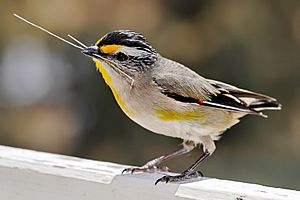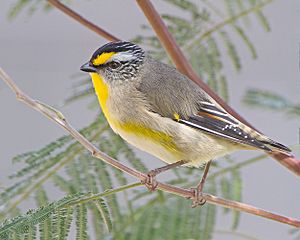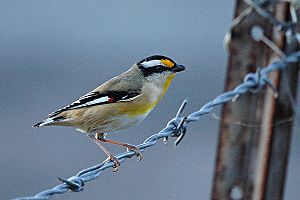Striated pardalote facts for kids
Quick facts for kids Striated pardalote |
|
|---|---|
 |
|
| Pardalotus striatus ornatus | |
| Conservation status | |
| Scientific classification | |
| Genus: |
Pardalotus
|
| Species: |
striatus
|
The striated pardalote (Pardalotus striatus) is a small, colorful bird found in Australia. It's the most common type of pardalote. People sometimes call it the pickwick, wittachew, or chip-chip because of its sounds. This tiny bird has a short tail and often hides in treetops. It makes a lot of noise while looking for small insects and a sugary substance called lerp. You might hear it before you see it!
Contents
Types of Striated Pardalotes
Scientists first thought there were four different kinds of pardalotes. Now, they are all grouped as different types, or subspecies, of the striated pardalote. They look a bit different depending on where they live.
Here are the main types:
- The yellow-tipped pardalote (subspecies striatus) lives mostly in Tasmania. But it flies over 200 miles across the Bass Strait to mainland Australia every winter.
- The striated pardalote (subspecies substriatus) is found in central and western Australia.
- The eastern striated or red-tipped pardalote (subspecies ornatus) lives along the warm east coast, including the Sydney area.
- The black-headed pardalote has two types (subspecies melanocephalus and uropygialis). They live from northeastern New South Wales up to northeastern Queensland, and across to the Kimberley region.
All these types have a black cap on their head. They also have a white stripe on their wing and a small, bright spot on the wing. This spot is usually red, but the yellow-tipped pardalote has a yellow spot.
What Striated Pardalotes Look Like
The way a striated pardalote looks can change quite a lot depending on where it lives. Their head is black, and some types have white streaks on it. They have a white stripe above their eye, which starts with a yellow mark near their beak.
All types have a white stripe on their wing and olive-green backs. As mentioned, the yellow-tipped pardalote has a yellow spot on its wing. All the other types have a red spot. Male and female pardalotes look very similar. Young birds have colors that are not as bright.
Other birds that look a bit like the striated pardalote include the spotted pardalote and the red-browed pardalote.
Where They Live
Striated pardalotes live in many different places across Australia. You can find them in tall mountain rainforests and even in dry, scrubby areas. However, they especially like eucalyptus forests and woodlands. They live in almost all parts of Australia, except for some deserts in Western Australia.
Behaviour
What Striated Pardalotes Eat
Striated pardalotes mostly eat insects and their larvae (young insects). They usually find their food high up in the leaves of eucalyptus trees. Sometimes, they come closer to the ground to feed on smaller bushes. They often feed in small groups.
Reproduction and Life Cycle
Striated pardalotes usually breed between June and February. The female bird lays two to five white, oval-shaped eggs. Their nest is made from bark fibers, roots, and fine grass. They build their nests in different places, like hollows in trees, tunnels they dig into the side of a bank, or even in cracks in human-made objects. Both the male and female birds take turns sitting on the eggs to keep them warm. They also both help to care for the young birds after they hatch.
Their Call
The striated pardalote has a clear, sharp, and musical call. It sounds like "witta-witta," with the second part being a bit lower. They repeat this call regularly for long periods. They also make soft, low trilling sounds.
Gallery
Images for kids
See also
 In Spanish: Pardalote estriado para niños
In Spanish: Pardalote estriado para niños







